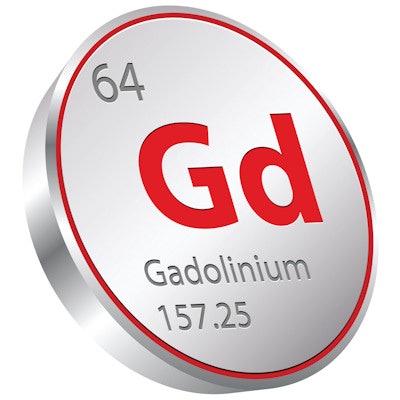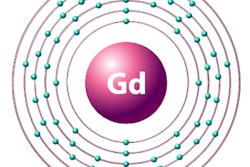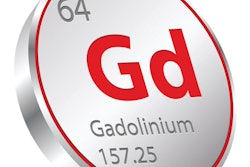
Taking what's described as a "wait and see approach," the International Society for Magnetic Resonance in Medicine (ISMRM) has published guidelines on the use of gadolinium-based MRI contrast agents in both clinical and research settings in an article published in the July issue of Lancet Neurology.
The guidelines address the thorny problem of gadolinium retention, in which patients who have received gadolinium-based contrast agents (GBCAs) retain trace levels of gadolinium in their brain tissue years after the studies were performed. Researchers have been trying to determine whether any clinical issues are related to gadolinium deposition and if different types of gadolinium agents are more prone to retention.
The new guidelines were published under the auspices of the ISMRM by a team led by Dr. Vikas Gulani, PhD, of Case Western Reserve University; other co-authors included MRI experts Fernando Calamante, PhD, of the University of Melbourne; Frank Shellock, PhD, of the University of Southern California; Dr. Emanuel Kanal of the University of Pittsburgh; and Dr. Scott Reeder, PhD, of the University of Wisconsin (Lancet Neurol, July, 2017, Vol. 16:7, pp. 564-570).
They describe how the first studies on gadolinium retention began appearing in 2014, and researchers found that patients had higher levels of signal intensity in their brain tissue that correlated to the number of GBCA-enhanced administrations they had received. Gadolinium was described as having crossed the blood-brain barrier, but gadolinium deposition was not related to renal function, as all patients with retained gadolinium had normal renal function.
One major question has been whether certain types of gadolinium agents -- linear or macrocyclic -- result in increased levels of gadolinium retention. A number of studies have shown that linear agents seem to be more prone to deposition, but the ISMRM review states that it's difficult to make a simple blanket generalization due to the wide number of variables that have been documented.
"We conclude that the simple classification of agents into linear or macrocyclic does not take into consideration the pharmacokinetic complexity of GBCAs with regard to gadolinium deposition, and fails to consider their clinically significant differences in relaxivity," or the amount of T1 shortening produced by agents.
Other issues that make it difficult to determine which agents might contribute to higher levels of gadolinium retention include patients who have damage to the blood-brain barrier prior to contrast administration, or those who have repeated injections over a shorter period of time. Ironically, many patients with evidence of gadolinium deposition have pathology in the same areas of the brain that are prone to retention.
Risk of harm?
Is there a risk of harm to patients from retained gadolinium? The ISMRM review states that no evidence of harm has been found in animal models, nor has there been evidence of changes in behavior in animals that received repeated gadolinium exams over a very short time period. While there have been anecdotal reports from patients who believe they have been affected by gadolinium toxicity, "no data exist linking adverse biological neurological or neurological effects to gadolinium deposition in the brain," the review states.
The authors also note the contradictory approaches to gadolinium taken by different regulatory authorities and academic societies. The U.S. Food and Drug Administration in May 2017 published a review of gadolinium safety but took no regulatory steps other than to advise healthcare practitioners to limit GBCA use to cases in which the additional information provided by contrast is necessary. On the other hand, the Pharmacovigilance Risk Assessment Committee (PRAC) of the European Medicines Agency has recommended that three linear gadolinium agents be pulled from the market.
In the end, the ISMRM statement concludes that the potential harm from retained gadolinium needs to be balanced against the known utility of GBCAs for clinical and research use. While the researchers said that the society's position on GBCAs is expected to evolve, they did make several recommendations:
- Use of gadolinium contrast should be avoided when not necessary, but GBCAs should not be withheld from patients who have clinical indications for gadolinium-enhanced MRI.
- The medical record of patients receiving gadolinium should include documentation of information such as the clinical indication for a GBCA, the specific agent used, and the dosage.
- Some gadolinium agents may deposit more gadolinium than others. While the data are discordant, it's believed that macrocyclic agents deposit less gadolinium than linear agents. Institutions should keep these factors in mind and "consider that some agents might have a greater propensity for deposition than others."
- The use of GBCAs in research settings is appropriate, but each institution should decide whether to disclose information on gadolinium retention to research subjects and what language to use in consent forms.
- Research investigators studying gadolinium deposition "should exercise meticulous disclosure" of relationships with industry as potential conflicts of interest. Transparency is "particularly relevant" for gadolinium studies.
- Future studies on gadolinium retention should "explicitly describe" the clinical history of all participants, including the treatment patients received, due to the potential of confounding factors to affect gadolinium deposition.
In a related commentary, Kevin Terashima and Dr. Daniel Reich, PhD, of the U.S. National Institutes of Health stated that the ISMRM guidelines "highlight our incomplete understanding of the gadolinium deposition phenomenon" and remind healthcare professionals that they should use caution when administering GBCAs while documenting thoroughly.
Ultimately, the strategy being taken by the ISMRM is a "wait and see approach" given the lack of evidence to support a blanket recommendation for using macrocyclic agents over linear products. Ultimately, the choice of which type of GBCA is used should be made locally -- "a reasonable, but not particularly helpful, compromise," they concluded.



















